How to find water for a well: an overview of the most effective ways to find water on a site
The device of its own water source in the suburban area will significantly increase the degree of comfort. Agree, bringing enough water to the country is an expensive undertaking, especially since some sections are far removed from the city. You decided to build a water intake, but do not know how to find water for a well?
We will help you deal with the intricacies of the search - the article provides various ways and methods that are in demand among the owners of suburban areas. Also selected video recommendations and colorful photos that clearly demonstrate the material presented.
Based on our recommendations, finding water on site will not be difficult for you. And you can provide yourself with the usual living conditions and enough water for personal use and construction needs.
The content of the article:
Aquifers and location in the ground
There is water underground, but it is not so easy to find. You can, of course, dig a hole at random in the hope of accidentally stumbling into an aquifer, but the result is likely to be disappointing.
Meanwhile, it happens that if you didn’t miss literally two meters, the desired goal would be achieved. After all, the water in the earth is between the layers of soil, which it is not able to erode due to its water-resistant composition, the basis of which is clay and rock.
Clay layers are interspersed with sandy layers, gravel and pebble deposits. They contain pure water. It is to such an aquifer that it is necessary to get to those who decided to dig a well in their area.
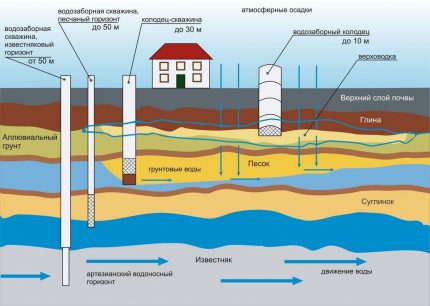
It should be noted that the aquifer is not the same in geometric parameters along its entire length. Somewhere the sand layer is thinning, and in other places it becomes wider and deeper.
The waterproof layer is also not the same: in one place it is horizontal, and in another it can bend or even bend. In places where the water-resistant layer is curved, the largest volumes of sand saturated with water are stored.
The effect of depth on water quality
If you dig a well in the exact spot where the water is located, the aquifer can be found even just some two, two and a half meters from the earth's surface. Knowledgeable people call such a water layer a water trap and do not use it for drinking.
Proximity to the surface is an unkind sign, because water has accumulated due to melting snow, infiltration of rain streams and the waters of nearby reservoirs. The quality of the water in it leaves much to be desired, because there is a high probability of seepage of sewage and other dirt.
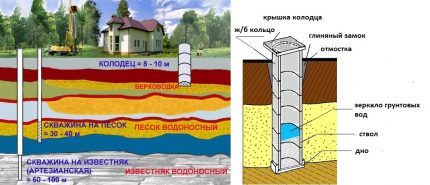
In addition, the mirror of such water is usually unstable. A well with a tip can completely dry out during the summer heat and be filled during the melting season of snows or prolonged autumn rains.
And this means that the water sources that feed on the water will also be empty, and summer residents will be left without water in the hot summer season, when it is especially needed. Under such circumstances, it is better to forget about the plans for the crop. Indeed, until late autumn, water in the well is not expected.
Therefore, we will seek deeper water. Experts believe that high-quality water is not so deep, only 15 meters from the soil level. In the sands, the water in which is clean and tasty. The sand layer in which water is “stored” is a natural filter. Passing moisture through himself, he cleans it of the remnants of dirt and harmful elements.
If you are interested in installing a personal water source in a summer cottage, you should compare the arguments for the device well or well, and also learn about their shortcomings. We suggest you familiarize yourself with the comparative review.
Search Observability
The ability to note everything and analyze the collected information has never been superfluous. It was in this way that our ancestors found water, which had not yet been armed with the achievements of science and technology. What facts and natural phenomena will help us in our search for water?
Observation # 1 - Summer Fogs
Fogs may appear on the site in the warm season. This natural phenomenon happens either in the early morning, or closer to evening. If you observe fog in your area, pay attention to its density: it will be the highest in the place where the water is closest to the surface of the soil.

The cause of this fog is the evaporation of water, which is underground. In one place, like a normal fog, it will not stand. Moisture vapors can swirl or spread very low above the ground.
Observation # 2 - Animal Behavior
Unlike humans, animals know exactly where the underground water is. It is a pity that they cannot tell us about this. Yes, they will not be able to tell, but please share your knowledge.
Observing the behavior of domestic and wild animals and birds, we can get all the necessary information:
- Dog. A dog is a friend of a person and she will certainly help him in finding water for a well. In hot weather, dogs are always looking for the opportunity to cool their body, so they dig holes where it is cooler. These are exactly the places we are looking for.
- Horse. Feeling thirsty, the horse hooves in the place where there is water underground.
- Harvest mouse. But mice love where it's dry. They will never craft their nests near wet areas. It’s better to climb a tree or some structure that rises above the soil.
- Domestic bird. Chicken does not rush where it is wet, and geese, on the contrary, choose for their nests the intersection of underground aquifers.
Even midges feel the proximity of water. If we look at her behavior at dusk, when the summer heat has already receded, then we will see columns of insects swirling in the air precisely over those places where it is the coldest - where there is what we need underground.
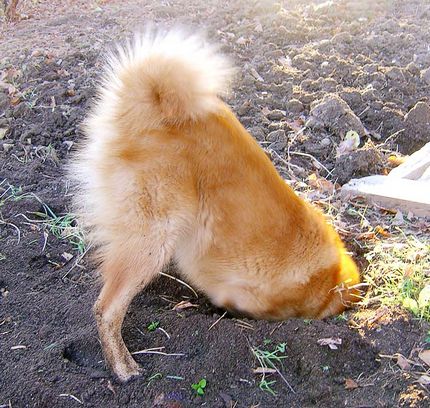
In a place involuntarily indicated to us by representatives of the animal world, you can safely beat abyssinian well for the extraction of water for irrigation of the garden and for the maintenance of the territory.
Observation # 3 - Species of Growing Plants
Who needs to know about the presence or absence of water on the site, if not the plants? It is not surprising that they are used as indicators. If blackberry, buckthorn, lingonberry, bearberry, bird cherry, wood louse and rosemary feel good on your site, then it makes sense to look for an aquifer - it is always present.

Take a closer look at the birch: its modest growth and a knotted trunk with curvature gives out the presence of a nearby watercourse. Coniferous trees also prefer to grow where it is dry.
By the way, the presence of nearby groundwater is not always a blessing for gardeners. After all, cherries and apples prefer moderate humidity: their overmoistening can provoke tree diseases and rotting of fruits.
Observation # 4 - helping friends and neighbors
If your site is part of a horticultural society or you have neighbors nearby, be sure to chat with them. As a rule, they have already solved the problems that you are struggling with today. If there is an operating well or well in their area, then you will have water.
The neighbors should find out at what depth the water in their source, whether the level in it is stable. Thus, it is simplest and easiest to collect information and plan work on well construction. For private traders, interviewing the owners of adjacent sites is the only feasible way to obtain hydrogeological data.

Try to find out not only the current state of local water intake, but also water level fluctuations throughout the year, as well as the composition of the water. You must admit that it is not too pleasant to find your site in the spring with flooded flood waters. Receive vital information for you in a timely manner.
Search Practices
When the observation stage is already over, and the neighbor said that he already bought the site with a well, the time has come for a practical search for water layers using standard or non-standard methods.
Method # 1 - using glass containers
Finding the right amount of glass jars of the same size is not a problem for those who periodically engage in home canning. If you don’t have cans, buy it, they will definitely need it sooner or later.
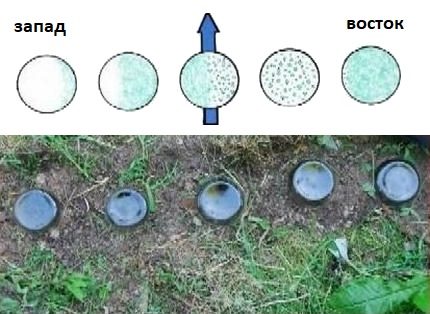
Throughout the site, you need to dig glass jars of the same size with the bottom up to a depth of at least 5 cm. The duration of the experiment is 24 hours. The next morning, until the sun rises, you can dig out and turn over the dishes.
We are interested in those banks in which there is condensate.Its more in banks located above the aquifers.
Method # 2 - the use of absorbent material
It is known that salt is hygroscopic, that is, it is able to absorb moisture even from air. Red brick, crushed into powder, has the same properties. Silica gel is another material that is perfect for our purposes.
For the experiment, we need several clay pots that are not coated with glaze. Choose a day when there has not been rain for a long time and we hope that it is not expected in the next day.
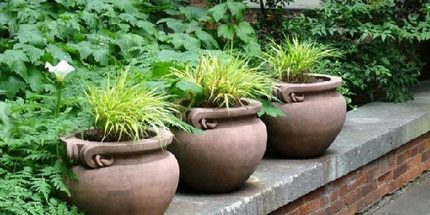
We fill the material in pots and weigh the resulting "devices". Pots are best numbered, and the data recorded. We wrap each pot with non-woven material and bury it at a depth of half a meter in the ground in different places of the site.
After a day, we dig out the bookmarks and re-weigh it. The heavier the pot has become, along with its contents, the closer to the place of its laying is the aquifer.
Almost scientific methods of dowsing
Despite all the skepticism of professional drillers, dowsing is still used today and gives good results. Consider two methods for such a search for water.
No. 1 - electrodes and aluminum wire
For this experiment, we need two pieces of aluminum wire 40 cm long. Bend 10 cm on each piece at right angles to the handles. For the remaining 25 cm, you will need a hollow tube, for example, from elderberry, with the core removed.
We insert the wire into the elderberry tubes so that it can spin freely inside the channel. By the way, instead of elderberries, you can use viburnum, willow or hazel.

We take one tube in each hand so that their ends look in opposite directions. We go along the site in a direction from north to south. Elbows should be pressed to the body. The frame, not tightly clenched in fists, serves as an extension of the hand.
In the place where there is an aquifer, the wires turn around and converge to the middle. It is possible that water may be on your right or left, then both tubes will “look” in this direction.
When you pass the aquifer, the tubes will again turn in different directions. To make sure that you are not mistaken, walk again over the place where the tubes were closed. This time in the direction perpendicular to the previous one (from east to west). If the closure is repeated, the right place is found and it is here that a well should be dug.
No. 2 - Willow Vine Based Search
We need a willow on which there is a branch, as if split into two parts, forming an angle of 150 degrees between themselves (approximately). This is actually a finished “frame” - the main tool that we will use. But the frame cannot be operated immediately. Be patient, let the wood dry first.
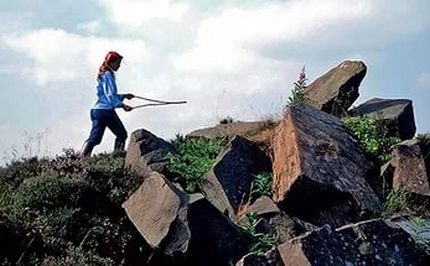
The finished frame is taken at the ends of the branches so that the "beak" located in the middle looks up. With this vine and you need to slowly go around the entire site. Above the place of occurrence of the aquifer, the vine "pecks", that is, the middle part of the frame will be directed downward.
Not every person knows how to handle the vine correctly, so dowsing is the destiny of a few. For those who are ready to test themselves, we recall that the most accurate values can be obtained using the frame:
- in the morning from 6 to 7 hours;
- after lunch from 4 to 5 hours;
- in the evening from 8 to 9 hours;
- at night from 12 to 1 o’clock.
Such studies bring results.But only the found water can turn out to be a top water or underground utilities passing under the site and collecting condensate.
Search for water by drilling
The final result can be obtained by exploratory drilling. He will put an end to all your doubts. To drill a well you need a garden drill. Since we have already discussed the merits of water located dangerously close to the earth’s surface, we’ll have to drill to a depth of at least 6 meters.
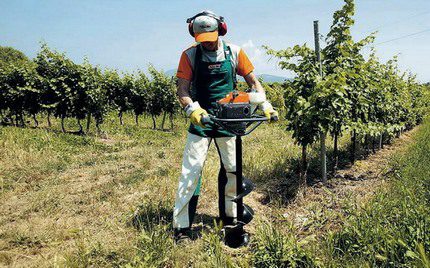
Suppose an aquifer is found. But, before you start digging the long-awaited well, you need to make sure that you find good quality water. To do this, send it to study the composition and degree of pollution in the sanitary and epidemiological station. Also water for analysis it will be necessary to hand over after arranging the water intake.
If the results obtained satisfy you, we can assume that the search for a place under the well is completed.
The most expensive and, at the same time, the most reliable way is to drill pits and punch wells using professional equipment.
Using it, we get the following information:
- the thickness of the soil on the site;
- quantity and quality of detected water;
- the depth of the aquifer;
- location of quicksand boulders and slabs;
- the approximate amount that we will need to build a well.
It’s not at all a fact that the place you scout will be conveniently located relative to the proposed buildings on your site, but sometimes the owners are lucky.
Finding the right place for digging a well five meters from your home. In this case, with an independent water supply with automatic water supply, the portion of pipes laid in the ground will be minimal. So it will require less investment.
Conclusions and useful video on the topic
Watch the video below, it will introduce you to dowsing methods. You will see the practical application of the dowsing method. Geologists do not recommend using this method, considering it pseudoscientific. If the method itself is controversial, then the ring manipulations that you see in this video are more than doubtful.
In our article, biolocation is mentioned solely for the purpose of providing the most complete information about all water search methods that are actually used in practice.
The next video will introduce the principle of studying soils and their condition by drilling methods. This video demonstrates the work of reconnaissance digging with the help of a probe (choke). This is a rather time-consuming process that is difficult to perform alone without using either a tripod or gate.
In addition, there is a real danger of collapse of the well, if you do not use a casing to fix it.
If you are looking for water for a well, you need to have an idea of the aquifers, how they are located underground and the effect of the depth of water on its quality characteristics.
Be observant in your quest. Follow the plants, natural phenomena and animals. Their behavior will help you determine if there is water in your area.
Folk search tools for water, as well as information received from neighbors, will not be superfluous. In addition, water is also sought by the biolocation method. The most effective, although time consuming, method of drilling is considered. Armed with the information received, you can begin to search. If there is water at your site, you are sure to find it.
Please write comments in the block below. Ask questions if they have arisen during familiarization with the information provided by us. Tell us and visitors of the site about your experience in determining the location for a well in a suburban area.

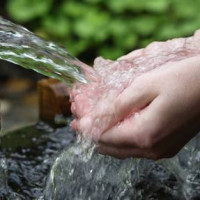 How to find water for a well: a review of effective aquifer search methods
How to find water for a well: a review of effective aquifer search methods 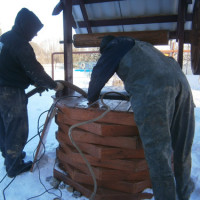 Water purification from a well: an overview of the best and most effective ways
Water purification from a well: an overview of the best and most effective ways 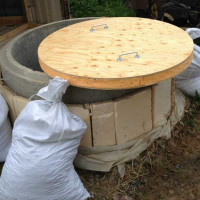 Do-it-yourself well warming for the winter: an overview of the best materials and methods of warming
Do-it-yourself well warming for the winter: an overview of the best materials and methods of warming 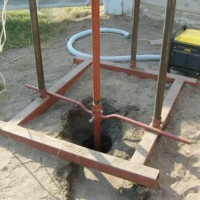 DIY water well: arrangement rules + analysis of 4 popular drilling methods
DIY water well: arrangement rules + analysis of 4 popular drilling methods 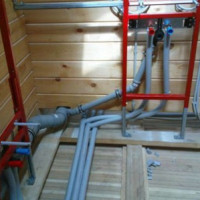 How to conduct water in a private house: arrangement of a source of water supply + water supply to the house
How to conduct water in a private house: arrangement of a source of water supply + water supply to the house  DIY Abyssinian well construction: how to make an igloo-well on a site
DIY Abyssinian well construction: how to make an igloo-well on a site  How much does it cost to connect gas to a private house: the price of organizing gas supply
How much does it cost to connect gas to a private house: the price of organizing gas supply  The best washing machines with dryer: model rating and customer tips
The best washing machines with dryer: model rating and customer tips  What is the color temperature of light and the nuances of choosing the temperature of the lamps to suit your needs
What is the color temperature of light and the nuances of choosing the temperature of the lamps to suit your needs  Replacement of a geyser in an apartment: replacement paperwork + basic norms and requirements
Replacement of a geyser in an apartment: replacement paperwork + basic norms and requirements
When I was looking for a place for a well, I was guided by two simple ways. At first, they decided with a friend to look for a place where birch trees grow, since there should be water, but in my area they do not grow, the method failed. After he decided to use the method with banks, he simply stuck them in the ground and looked for those in which the greatest amount of condensate - this method really helped. Now I have a good well and no problems are observed.
Dogs and horses are the best helpers in finding groundwater. Naturally, not all horses use herds in herds, but a dog, especially a village one, will immediately let you know where there is the necessary coolness underground. It is only necessary not to let her escape somewhere to the kennel or to the house. And it is desirable that the heat was not less than +25. By the way, there are quite a lot of birches in my area, I need to take them into service.
The best way to detect water in the area is to drill a test well. Not the cheapest, but the most effective way. Yes, you can stick bottles in the ground, walk with wire, but these are unscientific methods and they will never give a 100% result. It is better to spend money and work with a drill than to dig 10 rings of soil for nothing and not find water, or find water of poor quality. After all, the wire will not show alkalinity or hardness of water.
We have birch trees everywhere and fog everywhere. You can drill anywhere, only the water is oversaturated with divalent iron. There was a 20 meter well with good water, but after a severe flood, iron water started to flow. And where to look for good water now?
Most likely, you have a problem with melt water entering the wellhead. The clay castle around the casing may have been made incorrectly, or you didn’t do it at all.
The plot is narrow, they say there are no veins ... What to do - where to dig a well?
Hello. Who said that he lived no? It’s hard to answer you right away, we don’t know the region, whether the neighbors have water, or the terrain features, but we would advise you to invite an experienced person to search for water for the well. I doubt strongly that there is no water at all on the site.